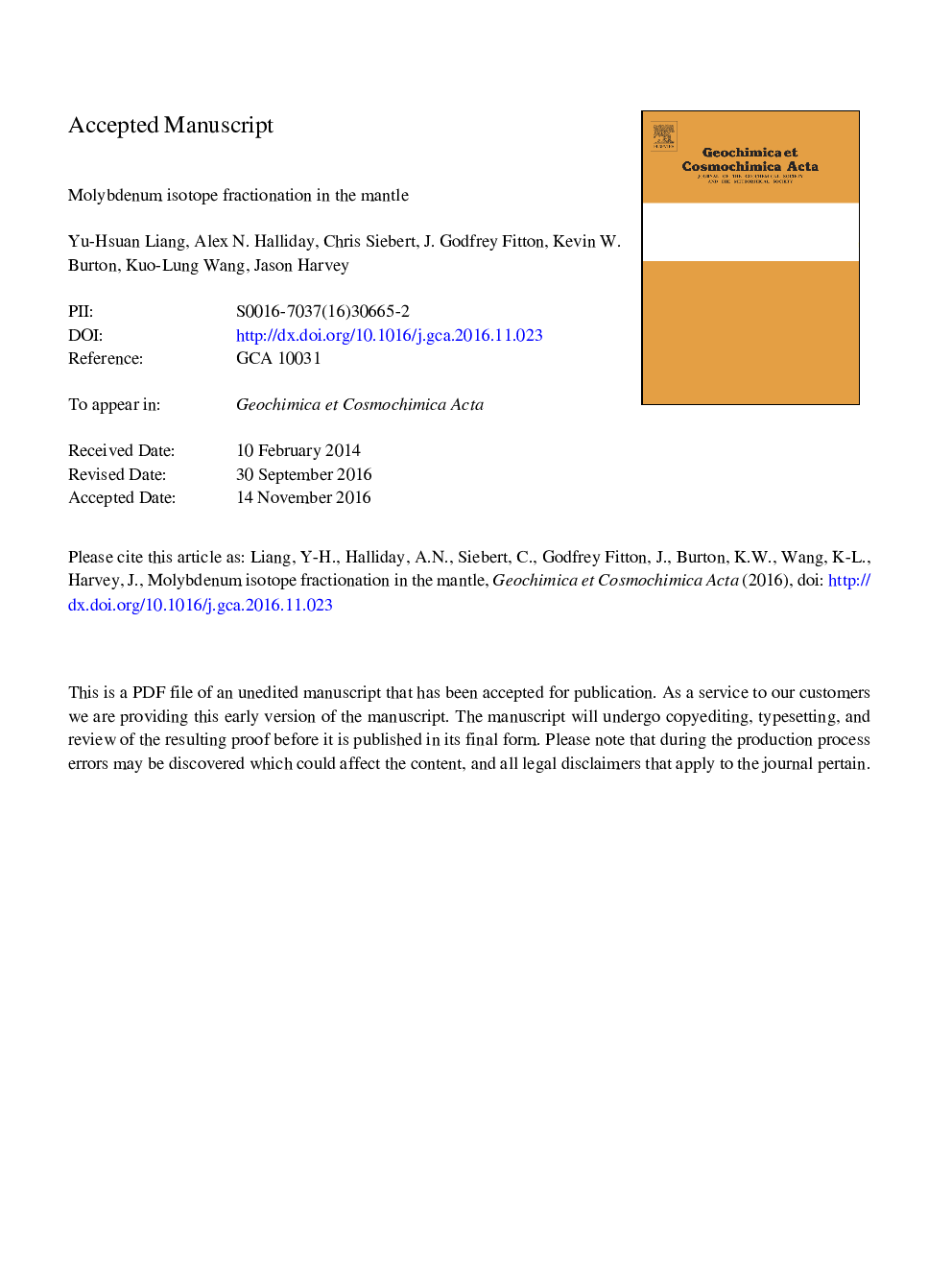| کد مقاله | کد نشریه | سال انتشار | مقاله انگلیسی | نسخه تمام متن |
|---|---|---|---|---|
| 5783364 | 1637958 | 2017 | 39 صفحه PDF | دانلود رایگان |
عنوان انگلیسی مقاله ISI
Molybdenum isotope fractionation in the mantle
ترجمه فارسی عنوان
تجزیه ایزوتوپ مولیبدن در گوشته
دانلود مقاله + سفارش ترجمه
دانلود مقاله ISI انگلیسی
رایگان برای ایرانیان
کلمات کلیدی
مولیبدن، تجزیه ایزوتوپ، زمین سیلیکات فله کندریت، سنگهای مشتق شده از گودال،
موضوعات مرتبط
مهندسی و علوم پایه
علوم زمین و سیارات
ژئوشیمی و پترولوژی
چکیده انگلیسی
We report double-spike molybdenum (Mo) isotope data for forty-two mafic and fifteen ultramafic rocks from diverse locations and compare these with results for five chondrites. The δ98/95Mo values (normalized to NIST SRM 3134) range from â0.59 ± 0.04 to +0.10 ± 0.08â°. The compositions of one carbonaceous (CI) and four ordinary chondrites are relatively uniform (â0.14 ± 0.01â°, 95% ci (confidence interval)) in excellent agreement with previous data. These values are just resolvable from the mean of 10 mid-ocean ridge basalts (MORBs) (0.00 ± 0.02â°, 95% ci). The compositions of 13 mantle-derived ultramafic xenoliths from Kilbourne Hole, Tariat and Vitim are more diverse (â0.39 to â0.07â°) with a mean of â0.22 ± 0.06â° (95% ci). On this basis, the isotopic composition of the bulk silicate Earth (BSE or Primitive Mantle) is within error identical to chondrites. The mean Mo concentration of the ultramafic xenoliths (0.19 ± 0.07 ppm, 95% ci) is similar in magnitude to that of MORB (0.48 ± 0.13 ppm, 95% ci), providing evidence, either for a more compatible behaviour than previously thought or for selective Mo enrichment of the subcontinental lithospheric mantle. Intraplate and ocean island basalts (OIBs) display significant isotopic variability within a single locality from MORB-like to strongly negative (â0.59 ± 0.04â°). The most extreme values measured are for nephelinites from the Cameroon Line and Trinidade, which also have anomalously high Ce/Pb and low Mo/Ce relative to normal oceanic basalts. δ98/95Mo correlates negatively with Ce/Pb and U/Pb, and positively with Mo/Ce, explicable if a phase such as an oxide or a sulphide liquid selectively retains isotopically heavy Mo in the mantle and fractionates its isotopic composition in low degree partial melts. If residual phases retain Mo during partial melting, it is possible that the [Mo] for the BSE may be misrepresented by values estimated from basalts. This would be consistent with the high Mo concentrations of all the ultramafic xenoliths of 40-400 ppb, similar to or, significantly higher than, current estimates for the BSE (39 ppb). On this basis a revised best estimate of the Mo content in the BSE based on these concentrations would be in the range 113-180 ppb, significantly higher than previously assumed. These values are similar to the levels of depletion in the other refractory moderately siderophile elements W, Ni and Co. A simpler explanation may be that the subcontinental lithospheric mantle has been selectively enriched in Mo leading to the higher concentrations observed. Cryptic melt metasomatism would be difficult to reconcile with the high Mo/Ce of the most LREE depleted xenoliths. Ancient Mo-enriched subducted components would be expected to have heavy δ98/95Mo, which is not observed. The Mo isotope composition of the BSE, cannot be reliably resolved from that of chondrites at this time despite experimental evidence for metal-silicate fractionation. An identical isotopic composition might result from core-mantle differentiation under very high temperatures such as were associated with the Moon-forming Giant Impact, or from the BSE inventory reflecting addition of moderately siderophile elements from an oxidised Moon-forming impactor (O'Neill, 1991). However, the latter would be inconsistent with the non-chondritic radiogenic W isotopic composition of the BSE. Based on mantle fertility arguments, Mo in the BSE could even be lighter (lower 98/95Mo) than that in chondrites, which might be explained by loss of S rich liquids from the BSE during core formation (Wade et al., 2012). Such a late removal model is no longer required to explain the Mo concentration of the BSE if its abundance is in fact much higher, and similar to the values for ultramafic xenoliths.
ناشر
Database: Elsevier - ScienceDirect (ساینس دایرکت)
Journal: Geochimica et Cosmochimica Acta - Volume 199, 15 February 2017, Pages 91-111
Journal: Geochimica et Cosmochimica Acta - Volume 199, 15 February 2017, Pages 91-111
نویسندگان
Yu-Hsuan Liang, Alex N. Halliday, Chris Siebert, J. Godfrey Fitton, Kevin W. Burton, Kuo-Lung Wang, Jason Harvey,
